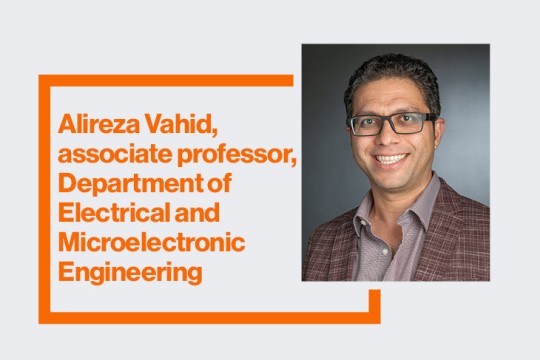RIT Helps High Schools Cultivate Next Generation of Imaging Scientists
A group of students at Victor Senior High School are learning how imaging science underpins some of the most critical technology of our time—from SARS screening to the Mars Exploration Rovers and medical diagnostics to military systems and homeland security.
Victor is the first school in the Rochester area—and possibly in the country—to offer an elective in imaging science, a blend of physics, chemistry, mathematics and computer science. Students there are learning how scientists create imaging-information systems to capture data on different wavelengths and solve scientific problems. For instance, the U.S. Forest Service uses special cameras on airplanes to detect heat on the infrared wavelength, which can help locate and track wildfires.
Mathematics teacher Shaun Goodrich introduced the unique elective with an eye to her students’ futures, exposing them for the first time to this multidisciplinary field in which the camera is only one element of a larger system.
“I see it as a nice bridge between high school and college,” Goodrich says. “It is another avenue to discover.”
A growing field, imaging science has been a mainstay at Rochester Institute of Technology since 1985. RIT is the only university in the country to offer undergraduate and graduate degree programs in this field of study.
Like college freshmen, Goodrich’s class of high school juniors and seniors learns about imaging science through lectures, hands-on laboratories and visits from RIT imaging science faculty.
“The curriculum is similar to the freshman-level class at RIT,” says Joe Pow, associate director at RIT’s Chester F. Carlson Center for Imaging Science. “It’s based on the imaging chain—a conceptual model that describes everything involved in creating a visual rendering of an object or phenomenon.”
Last summer, Pow worked closely with Goodrich and Robert Callens from Honeoye Falls-Lima High School, to develop a series of lessons and experiments appropriate for high school students. The teachers had previously learned about introducing imaging science into the classroom during an image-processing workshop held at RIT three years ago.
Next year, Callens at HF-L will teach a new yearlong applied physics elective that will include the study of imaging science.
“There has been a great deal of interest in this course by our students,” Callens says. “We have enough students signed up to have two sections next year.”
Goodrich and Callens will share their experiences developing an imaging science curriculum for high school students during the CIS Industrial Associates meeting to be held May 11-12 at RIT.
“Their talk will be webcast so that other teachers interested in this will have an opportunity to watch it on the Internet,” Pow says. “We hope to attract a nationwide audience.” (For more information, visit www.cis.rit.edu/info/IA_S2004.html.)
In addition, Pow would like to offer another round of summer workshops to interested high school teachers. He eventually hopes to export the class to other schools in the area and around the country.
For more information, contact Joe Pow at 585-475-7323 or pow@cis.rit.edu.














